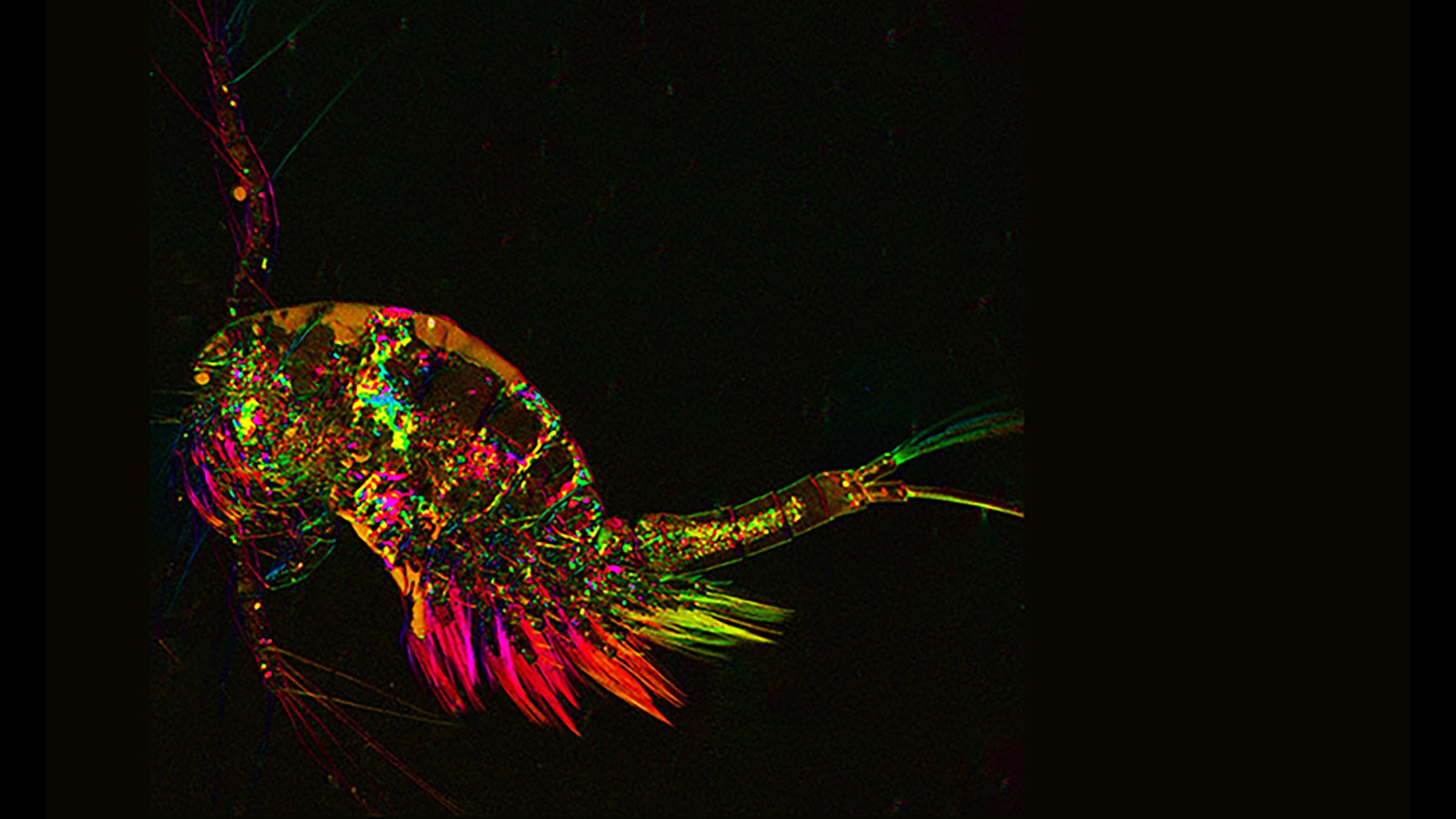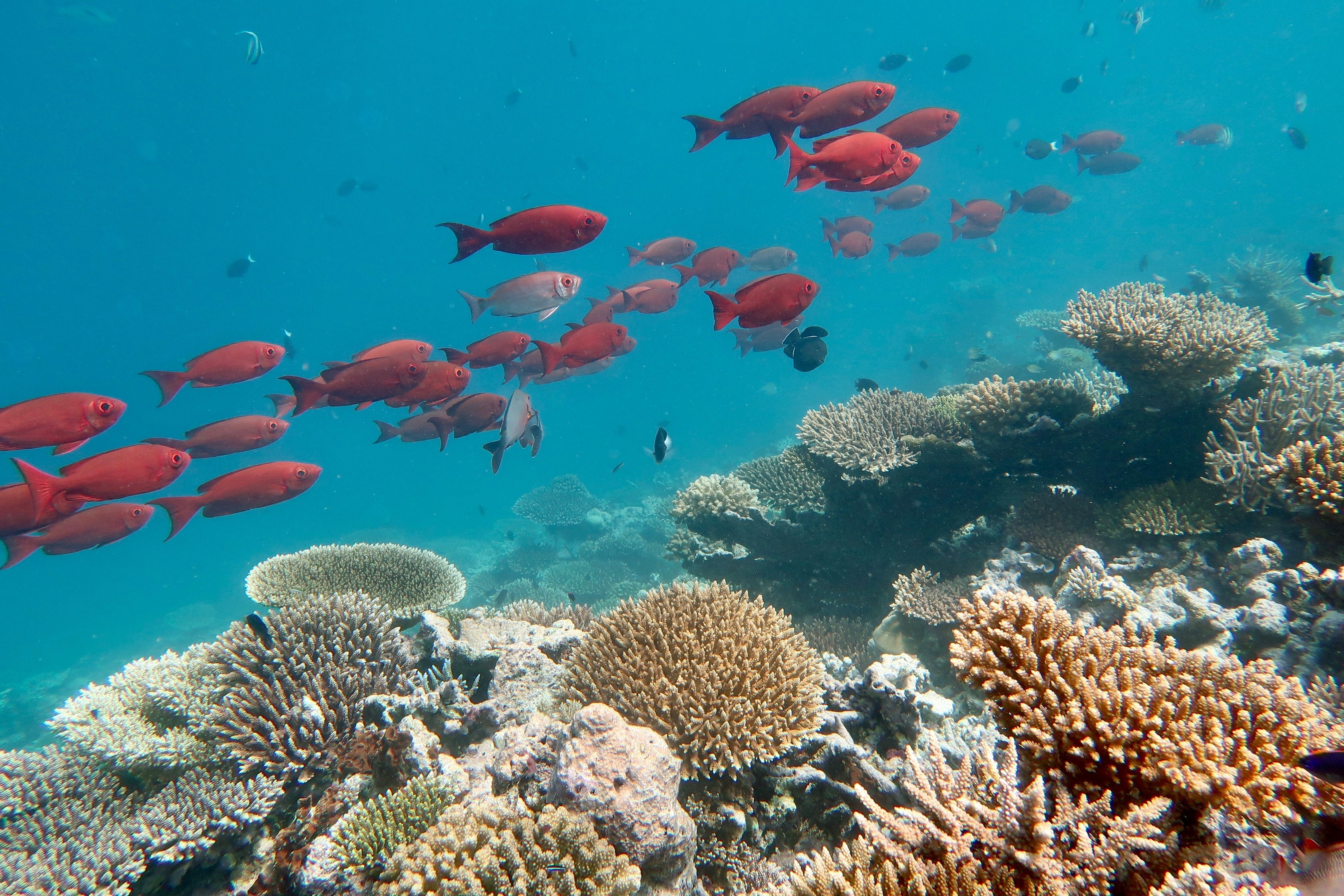The Mighty Copepod
These teeny shrimp-like critters at the bottom of the ocean food web seem totally unimportant.

But throw in an oil spill and some well-intentioned human intervention and they can have a huge impact, right up to the top of the food web, including sea turtles, dolphins and humans. Meet the mighty copepod.
TRANSCRIPT
Marc Airhart: This is Point of Discovery. If I ask you to think of something FAST, what comes to mind? A speeding bullet? A jet airplane? A roadrunner? You probably wouldn't think of the lowly copepod. But you should. Copepods are tiny little crustaceans – cousins to shrimp and crabs – that range in size from dust specks to blueberries.
Ed Buskey: … everything in the ocean, just about, likes to eat copepods, so they have lots of really interesting defense mechanisms …
MA: That's Ed Buskey, a professor at the University of Texas Marine Science Institute in Port Aransas. Copepods have big antennae with delicate little hairs to detect ripples in the water from approaching predators. When they sense danger, they zip away faster than you can say Michael Phelps.
EB: … one of the things that's interesting about copepods is they can have escape behavior that reaches speeds of up to about 500 or more body lengths per second … that would be the equivalent of swimming at about 2,000 miles per hour if you were a six-foot-tall human being. So they can really move …
MA: Buskey has been looking into what happens to copepods – and all the animals that eat them – after an oil spill, like the Deepwater Horizon spill in 2010. This is important because oil contains a host of toxic compounds, like polycyclic aromatic hydrocarbons, or PAHs.
EB: What are the effects … on reproduction, on behavior and so on? And also just to what extent are these harmful chemicals like the PAHs absorbed into their body and then have the potential to be transferred along the food web into higher organisms?
MA: In other words, how much of the nasty stuff in spilled oil makes its way into the seafood we eat? And how much of it winds up in the beautiful, but precarious marine life we'd like to protect like corals, sea turtles and dolphins? To get a handle on that, Buskey says you have to start near the bottom of the marine food web, with our friend, the copepod. Unfortunately, because copepods are tiny and move lightning fast, they aren't so easy to study. Buskey would love to catch them on film, but that can be tough.
EB: So you know the real problem when looking at anything that's really small is that the optics of the lens typically make a very narrow depth of field, so you can only have one thing in focus,and for an animal that's moving around in three dimensions, it's really hard to keep that image in focus ...
MA: The solution? Holography. Which is basically a way to record information about three-dimensional objects onto a two-dimensional image—using lasers. Just think of Princess Leia's holographic video in the film Star Wars. Holography brings everything within a three dimensional space into sharp focus. Buskey and his colleagues start by putting some copepods into a little tank of water; they shine a green laser on them [SFX: laser hum] and record a holographic movie. They can slow down the hologram, rotate it and zoom in and out. And soon they have what they're looking for: holograms clear enough to reveal new things about what happens to the copepods after an oil spill. Specifically, they can see what happens when you take copepods and oil and add some human-made chemicals called dispersants.
MA: When a major oil spill happens, response teams will often pour chemical dispersants into the water to try to blunt the environmental impact.
EB: Basically what dispersants do is make it easier for the oil to break up into small droplets, you know just like when you put detergent … in the sink when you've stuck a greasy pan … in the sink. It's not that the oil or the grease goes away, it just breaks up into really small droplets that you can't see …
MA: Dispersants used in oil spills might help keep birds safe from oil slicks on the surface and protect nearby habitats like coral reefs and beaches. Dispersants are also meant to turn the oil into little droplets that are easier for the ocean's bacteria to break down. These bacteria assist with the clean up after an oil spill, essentially devouring the droplets. Copepods, by contrast, don't normally eat oil because the drops are too big. But Buskey and his team found from the holography that when a dispersant converts the oil into tiny droplets, copepods tuck in to the droplets like potato chips.
EB: In fact we've done some experiments where we give them little plumes of rising oil droplets and they'll just sit there and then when they find them, they'll just sit there and eat them …
MA: That was one troubling discovery – that when dispersants are added to oil, copepods eat a lot more oil and absorb a lot more toxins. And there was more bad news: some holography studies show that the copepods exposed to oil and dispersants swim more slowly. So if copepods are absorbing more oil and toxins into their bodies—AND they can't get away from predators as easily—then maybe dispersants are actually passing more toxins up the food web.
Buskey's copepod work is one thread in a larger, multi-institution effort he leads called the DROPPS consortium. DROPPS researchers are studying how oil breaks up as a result of waves, turbulence and chemical dispersants and how the tiny droplets of oil produced by dispersants interact with various levels of the food web. The data they are collecting can help improve a computer model to help predict where oil will travel following a spill and what impacts it could have on marine life. That can be a critical tool for governments, oil companies and environmental groups in the hours and days following the start of an oil spill.
EB: And then the ultimate goal is to make that model good enough so that again decision-makers can decide … when it's best to use dispersants, when it's best to … use other methods …
MA: To see some images of copepods and videos from the hologram research, visit us online at pointofdiscovery.org. Point of Discovery is a production of the University of Texas at Austin's College of Natural Sciences. I'm Marc Airhart. Thanks for listening.
More Cool Science
Despite the fact that copepods are able to sense extremely small ripples from approaching predators and have lightning fast swim reflexes, seahorses can still manage to sneak up on them. Ed Buskey, who heads the DROPPS consortium, and research scientist Brad Gemmell used holography to reveal how the seahorse does it: the seahorse's head is shaped to minimize the disturbance of water in front of its mouth before it strikes. Just above and in front of the seahorse's nostrils is a kind of "no wake zone," and the seahorse angles its head precisely in relation to its prey so that no fluid disturbance reaches it.



